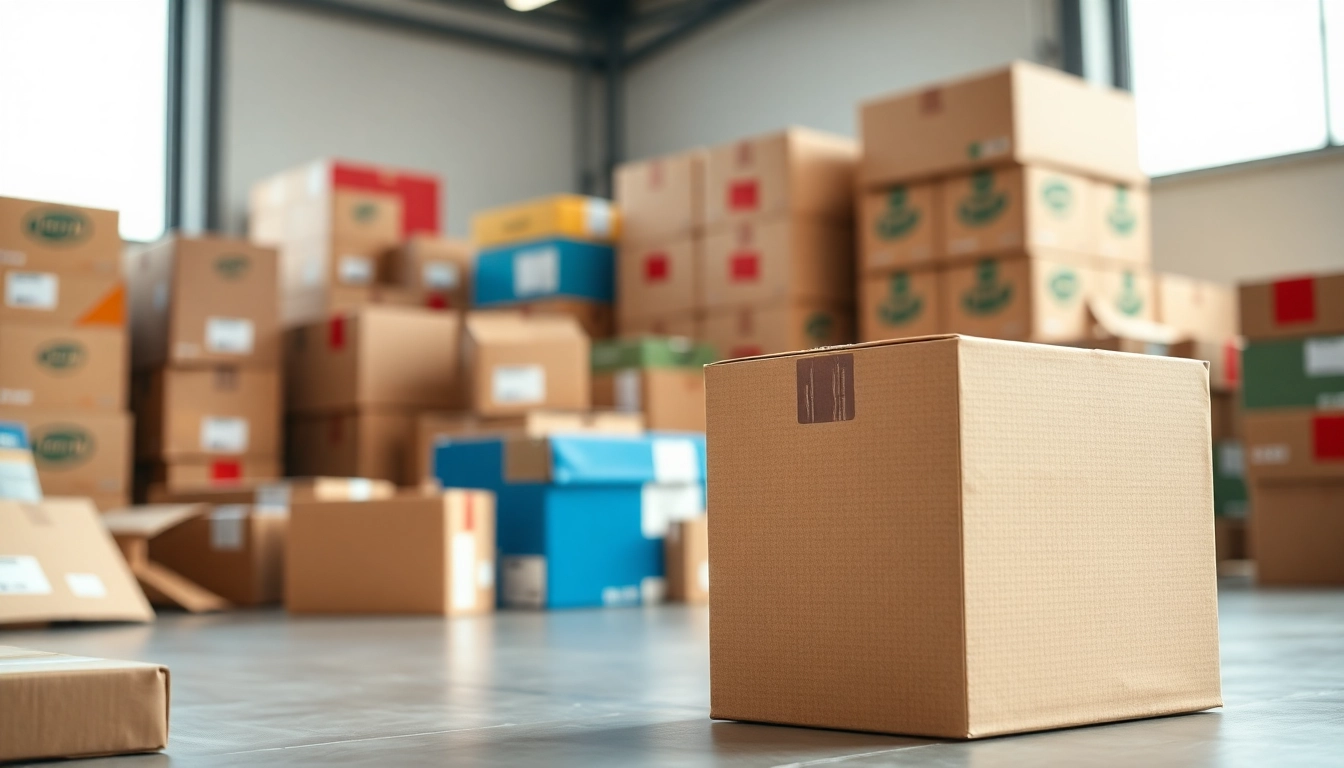Understanding Different Types of Boxes
When it comes to shipping and storage, the type of box you choose can make a significant difference in the efficacy of your logistics. Understanding the various types of boxes available will allow you to select the best fit for your specific needs. Whether you require boxes for moving, shipping, or storing items, the right choice can ensure that your products arrive safely and efficiently. Below, we will explore the most common types of boxes with their distinct advantages and applications.
Cardboard Boxes: Versatile and Cost-Effective
Cardboard boxes are among the most commonly used shipping and packaging options. Made from flat sheets of material that can be easily folded and glued, they are available in various sizes and strengths. The versatility of cardboard boxes makes them suitable for everything from lightweight items to much heavier products.
One of the significant benefits of cardboard boxes is their cost-effectiveness. They are inexpensive to manufacture, making them an attractive option for businesses that ship products regularly. Moreover, they are lightweight, which can help decrease shipping costs that are typically based on weight.
In terms of eco-friendliness, many manufacturers also offer recycled cardboard options, further enhancing their appeal. Businesses looking for sustainable practices can find cardboard boxes that meet their environmental goals without sacrificing quality or performance. Additionally, they can be easily customized, providing companies with the opportunity to enhance branding through printed designs.
Plastic Boxes: Durable Options for Sensitive Items
For items that require a bit more protection, plastic boxes are an excellent alternative. Made from materials such as polyethylene or polypropylene, these boxes are known for their durability and resistance to moisture and chemicals. This makes them ideal for storing or shipping sensitive products that may be affected by environmental factors.
Plastic boxes come in various shapes and sizes, including stackable options that help optimize storage space. They are often used in industrial, agricultural, and food processing applications due to their strength and reliability. Although they tend to be more expensive than cardboard boxes, their long-lasting nature can result in cost savings over time, particularly for businesses that frequently ship delicate items.
Another significant advantage of plastic boxes is their reusability. While cardboard boxes may need to be replaced after a single use due to wear and tear, plastic boxes can withstand repeated usage, making them a more sustainable choice for those who require consistent storage solutions.
Custom Boxes: Branding and Presentation Matters
Custom boxes are essential for businesses that want to enhance their brand image while ensuring that their products arrive in style. These boxes can be tailored to meet specific dimensions and printed with the company’s logo, colors, and any additional branding elements that reflect the brand’s personality and values.
Custom boxes not only serve functional purposes—like packaging and protecting products—they can also elevate the unboxing experience for customers. In a competitive market, this can lead to increased customer satisfaction and brand loyalty. E-commerce brands in particular find immense value in using custom boxes, as they can effectively convey their brand story right from the moment a customer receives their order.
Additionally, custom boxes can be designed with unique features, such as compartments and inserts that help keep products secure and beautifully presented. While they may require a higher upfront investment, the return on investment in terms of brand perception and customer engagement can be significant.
Assessing Your Shipping Requirements
Selecting the right box involves considering several factors specific to your shipping requirements. Here are key considerations to keep in mind before making your choice.
Weight and Size Considerations for Boxes
Understanding the weight and size of the items you are shipping is crucial in determining the appropriate box. Lightweight items can be securely packaged in smaller cardboard boxes, while heavier items may require reinforced boxes or additional padding to ensure safe transport.
The dimensions of the box should also be appropriate for the items being shipped. A box that is too large can lead to unnecessary movement during transit, increasing the risk of damage, while a box that is too small can result in crushing or other forms of damage. Careful measurement and selection based on the dimensions of your products are essential for successful shipping.
Impact Resistance: Protecting Your Products
Impact resistance refers to a box’s ability to prevent damage from physical shocks during handling and transit. For businesses shipping fragile items, such as glassware or electronics, selecting boxes specifically designed for impact resistance is vital.
Materials like double-walled cardboard or specialized plastic can provide an extra layer of protection. Additionally, incorporating packing solutions such as bubble wrap and foam cushioning can further shield items from impact and pressure-related damage during shipping processes.
Businesses can also conduct drop tests to assess the durability of their packaging and identify potential points of failure. This proactive approach can lead to improvements in packaging choices that ultimately protect your products and reduce return rates.
Environmental Impact: Choosing Sustainable Boxes
The environmental impact of packaging materials is becoming increasingly important to consumers. Many customers now prioritize eco-friendly shipping practices when selecting businesses for their purchases. As a result, choosing sustainable packaging solutions is not only ethically responsible but also beneficial for your brand image.
When assessing box options, look for products made from recycled materials or those that are fully recyclable or biodegradable. Brands can also reduce their ecological footprint by minimizing excess packaging material and employing innovative designs that utilize fewer resources.
Communicating your sustainability efforts to your customers, including clear information about material sourcing and end-of-life recyclability, can differentiate your business in a crowded marketplace and attract eco-conscious consumers.
Best Practices for Packing Boxes
Once you have selected the appropriate type of box, knowing how to pack your items securely can ensure they arrive in perfect condition. Here are some best practices to follow when packing boxes for shipping.
How to Pack Boxes Securely
Packing boxes securely involves more than simply placing items inside a box. Here’s a step-by-step guide to ensure the safety of your products during shipping:
- Prepare your box: Choose a sturdy box that can withstand the weight and pressure of the items you are shipping. Ensure the box is clean, dry, and undamaged.
- Use cushioning materials: Bubble wrap, packing peanuts, or crumpled paper should be used to provide cushioning and prevent movement within the box. Place cushioning at the bottom of the box before adding your items.
- Place items appropriately: If stacking items, place heavier objects at the bottom and lighter ones on top. Ensure that items are snugly packed and do not shift during transit.
- Fill void spaces: Any empty spaces should be filled with cushioning material to prevent items from shifting or colliding with each other during transport.
- Seal securely: Use high-quality packing tape to seal the box, ensuring all edges are securely closed. Avoid using string or twine, as they can get snagged on machinery.
Labeling Boxes for Easy Identification
Proper labeling is essential for ensuring packages reach their intended destination without confusion. Effective labeling includes providing clear information about the contents of the box and handling instructions. Here are some tips for labeling:
- Use a clearly visible font: Ensure the text on the label is easy to read, using a font size that stands out against the label background.
- Include essential information: Labels should include the recipient’s address, return address, tracking number, and any handling instructions or warnings (e.g., “Fragile” or “This Side Up”).
- Securely affix labels: Use high-quality label tape to ensure labels do not fall off or become unreadable during transit.
Optimizing Space in Your Boxes
Space optimization is essential for both cost-efficient shipping and maximizing the use of materials. If a box is not filled properly, it can lead to increased shipping costs and a higher risk of damage. Here are some strategies to improve space optimization:
- Choose the right box size: Use boxes that closely match the size of the items being shipped to minimize empty spaces.
- Stack items: If items can be safely stacked, utilize this method to make the most of vertical space in the box.
- Use flat packing for clothing or soft goods: For clothing or similar items, consider rolling or folding flat to maximize the space efficiently.
- Consolidate items: When possible, group smaller items together to minimize the number of boxes needed for shipping.
Where to Purchase Quality Boxes
Finding reliable sources for quality boxes is critical for ensuring your shipping needs are consistently met. Here, we will outline options for purchasing boxes both locally and online.
Local vs. Online Options for Boxes
When looking for boxes, businesses typically have two primary options: local suppliers and online retailers. Each option has its advantages and disadvantages:
- Local Suppliers: Purchasing from local suppliers allows you to inspect the quality of boxes before buying. This option is excellent for businesses that want to establish a long-term relationship with their supplier. However, inventory limitations may restrict variety.
- Online Retailers: Online shopping offers access to numerous types of boxes and customizable options, often at competitive prices. Many online suppliers also offer bulk buying discounts. Nevertheless, shipping times and costs could be a drawback when immediate supply is required.
Evaluating Suppliers for Quality Assurance
Quality assurance is crucial when choosing a supplier of boxes. Here are some factors to consider when evaluating potential suppliers:
- Material quality: Ensure that the supplier offers boxes made from high-quality materials that meet your durability needs.
- Product variety: A wide range of box types indicates a supplier’s capability to meet varied shipping requirements.
- Customer service: Evaluate the level of customer service provided, including ease of communication, response time, and the availability of support for troubleshooting any issues that may arise.
- Reviews and testimonials: Research other customer experiences with the supplier to get insights into the level of satisfaction and product quality.
Bulk Buying Boxes: Cost Savings and Convenience
Purchasing boxes in bulk can provide significant cost savings and ensure you always have a supply on hand. Bulk buying not only reduces the cost per unit but also minimizes the frequency of orders, freeing up time for you to focus on other areas of your business.
When considering bulk purchases, it’s essential to assess your forecasted shipping volume to ensure that you have adequate storage space. Establishing a reliable supplier for bulk orders can also lead to longer-term discounts and special rates tailored to your business needs. Just be sure to verify quality, as large orders could include variations in box strength and reliability.
Measuring the Success of Your Box Choice
After implementing your box strategy, it is imperative to measure its success continuously. Monitoring various metrics can offer insights into your box choice’s efficiency and effectiveness.
Customer Feedback on Box Performance
Gathering customer feedback on box performance allows businesses to understand their customers’ experiences during shipping. Send surveys or request reviews to learn how well boxes protected products and whether customers perceived value in the packaging. Positive feedback can reinforce good practices, while negative comments highlight areas requiring improvement.
Returns Analysis: Box Durability Under Pressure
A returns analysis provides valuable information about the durability of your box choices. Track return rates, specifically noting if returns are related to packaging issues, such as damage during shipping. This analysis can reveal patterns that necessitate a reevaluation of box types or packing practices.
Cost Analysis of Various Box Types
Conducting a cost analysis on various box types used will help you uncover efficiencies and areas for savings. Regular analysis can reveal changing trends in shipping costs, packaging options, or customer preferences, allowing you to adjust your box strategy dynamically as needed.



